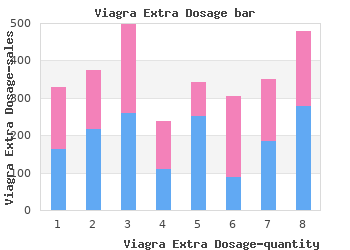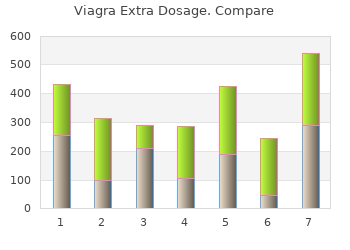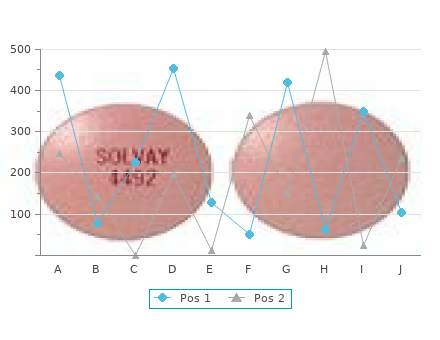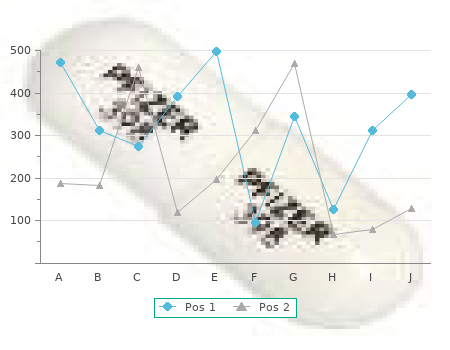Viagra Extra Dosage
By F. Murat. Olivet Nazarene University.
Distribution of etiological agents in patients with aureus and Enterobacteriaceae such as Escherichia coli endocarditis (adapted from Wisplinghoff and Seifert [50]) buy viagra extra dosage 130mg online. Fever, heart murmur, malaise, Staphylococcus aureus 23% 22–31 anorexia, weight loss, night sweats and myalgia may Coagulase-negative staphylococci 7% 6–8 or may not occur. Most neurological complications may go valve and grow into vegetations measuring up to several unnoticed. The pathophysio- are listed with their overall frequency of isolation in logical process can be divided into several stages: Table 18. Different clinical conditions favor certain formation of nonbacterial thrombotic endocarditis microbes, e. Even a minor trauma such or abscess; or new partial dehiscence of as tooth brushing or tooth extraction may lead to a prosthetic valve temporary occurrence of bacteria in the bloodstream or New valvular regurgitation (worsening or (transient bacteremia). Adhesion Predisposition (predisposing heart condition or injection to fibrin and platelets or to the surface of medical drug use) devices, such as artificial heart valves, is facilitated by virulence factors, many of which have been identified Fever (temperature >38 C) in staphylococci, streptococci, and enterococci. Vascular phenomena Following adhesion, bacteria stimulate the depos- major arterial emboli, septic pulmonary ition of further fibrin and platelets and a secluded infarcts, mycotic aneurysm, intracranial compartment is formed, which hides bacteria from hemorrhage, conjunctival hemorrhage, and the host immunological defense. The microorganisms Janeway’s lesions proliferate and produce a mucilaginous polysac- Immunological phenomena charide matrix which is called biofilm. In a biofilm less than 10% of bacteria divide actively and respon- glomerulonephritis, Osler’s nodes, Roth’s spots, 262 siveness to antimicrobial treatment is decreased. Impairment of the causative organism and its antimicrobial susceptibil- cerebral blood flow can lead to transient ischemia ity. Depending on the localiza- With the use of current technology, culturing about tion and duration of reduced blood flow, focal clinical 40–60 ml of blood is considered sufficient. When multiple emboli occlude several chances of a successful isolation are higher when independent vessels, multifocal clinical signs may blood cultures are drawn at the beginning of a fever become apparent. Emboli from the right heart according to the results of antimicrobial susceptibility are filtered by intrapulmonary arteries and cause pul- testing. Therefore, tricuspid valve endo- lines that recommend specific drug treatment carditis, which is common among intravenous drug schemes for certain organisms [14, 15]. However, in rare cases duration of antimicrobial therapy is at least 4–6 paradoxical embolism has been reported. A brain In addition to antimicrobial drug treatment, sur- abscess occurs after hematogenous seeding of bacteria gical therapy needs to be considered in the case of to the brain parenchyma. The early stage is called cerebritis considered to be at a high risk during cardiac surgery. A typical histological finding is a central necrotic replacement surgery should be performed later than area containing bacteria and debris and a hyperemic two weeks after stroke. In many performed at earlier time points, but available data cases antimicrobial therapy of a brain abscess alone are scarce and thus careful judgement is required in is unsuccessful and has to be backed by surgical each individual case. Hematogenous seeding of microorganisms to the Occlusion of cerebral arteries by septic or sterile meninges causes bacterial meningitis. The resulting emboli that originate from the vegetations is a inflammation can damage arterial vessel walls and common cause for stroke in infective endocarditis cause mycotic aneurysms (see below). Section 4: Therapeutic strategies and neurorehabilitation Embolic stroke due to Chagas disease Table 18. Chagas disease is an infection with the protozoan parasite Trypanosoma cruzi which is most prevalent Age group Main pathogens in South and Central America. It is transmitted by an Neonates Enterobacteriaceae, Streptococcus insect vector (Triatoma and other assassin bug ( 1 month) agalactiae (group B species) and can lead to a persistent chronic infection. Conditions that predispose to cardiac Neisseria meningitides emboli in Chagas disease are cardiac arrhythmias, congestive heart failure, apical aneurysms and mural thrombus formation. By the time stroke occurs, the damage to the heart is irreversible and thus effort Common complications of acute bacterial menin- needs to be directed towards prevention of Trypano- gitis include raised intracranial pressure, seizures, and soma infection by vector control and improvement of hyponatremia. Stroke is most prevalent in infants (less basic housing conditions, as well as early diagnosis than 1 year of age) with an incidence of up to 10%, and treatment. Most likely, the Meningitis as a cause of stroke spreading inflammation involves intracranial vessels Meningitis denotes the inflammation of the leptome- and leads to thrombosis and subsequent ischemia or ninges, which consist of the pia mater and arachnoid hemorrhage [17]. There are many infec- by bacteria or fungi leads to an inflammatory response tious and non-infectious causes of chronic meningitis which causes the typical clinical symptoms, headache and despite advances in diagnostic techniques, such and nuchal rigidity. Other less Tuberculous meningitis frequent symptoms are photophobia, seizures, Tuberculous meningitis is caused by Mycobacterium petechial bleeding, and arthritis. The disease occurs tuberculosis, a hardy slow-growing bacterium whose in all age groups, but the causative organisms vary only natural reservoir is the human. If left untreated, the inhalation, phagocytosed by alveolar macrophages disease is fatal. Empiric antimi- weeks, mycobacteria are undetected by the cellular crobial treatment needs to be initiated as early as immune system and spread to the draining hilar possible with antimicrobials that reach adequate bac- lymph nodes. Chapter 18: Infections in stroke Granulomata are caseous foci with a fibrotic cap- individuals with a defect in cellular immunity (e. The frequency of ischemic complications is teria contained and prevent further spread of infec- unknown, but stroke is associated with a worse out- tion.


There are simple partial seizures accompanied by auditory +/- visual hallucinations cheap viagra extra dosage 150mg visa. Most cases are due to an unstable expansion of a dodecamer repeat in the 5’ region of the cystatin B gene on 21q22. Unprovoked generalised or multi-focal seizures of tonic and/or clonic type are seen. There may be breathlessness, eye symptoms, or other indicators of autonomic involvement. A minority re-occur during the school years or in young adulthood when seizures may be proved (e. Two-thirds are left with a receptive language deficit, but the remainder recover completely. Acquired epileptic opercular syndrome This is a variant of Landau-Kleffner syndrome. Present* absent probably Absent present no Absent absent no Present present yes *Epilepsy is most likely present if there is a collateral history, if you can see the event, if there is a suggestive cause like tumour or epiloia, if there are signs like scars/bitten tongue/incontinence, if there is a family history (40% of idiopathic generalised cases), etc. Aura (epigastric sensation, vertigo, visual and somatosensory phenomena) is common. There may be myoclonic jerks3028, deviation of the eyes, flickering of eyelids3029, and vocalisation that may confound the unwary diagnostician. International classification of epilepsies and epileptic syndromes 3028 Usually these consist of minor twitches and must be distinguished from tonic-clonic seizures. Unpleasant contralateral face/limb sensations (tingling/electric) experienced - can spread in Jacksonian-like manner in a seconds (much faster than focal sensory episodes in migraine). Causes of death in epilepsy Unrelated Seizures Unexplained sudden death 3036 Drowning Other accidents 3037 Suicide (c. Population-based studies suggest that mortality is related more often to underlying aetiology rather than the seizures. Prognosis: Factors associated with a poor prognosis are a high frequency of tonic-clonic seizures before treatment, partial seizures, neurological deficit, psychiatric and social problems (stress, low socioeconomic status and poor educational attainment), a family history of epilepsy, and a poor response to treatment. Drug-resistant epilepsy may be more common when seizures are not arrested early on by treatment. About one child in 30 has at least one febrile convulsion between the ages of 6 months and 6 years, especially between 2 and 4 years. Sadleir and Scheffer (2007) suggest buccal or intranasal midazolam for the 9% of cases with prolonged febrile seizures. In fact, in the small number of cases who do develop epilepsy the causative role of febrile seizures is tenuous. In some cases febrile seizures persist after age 6 years, plus or minus afebrile seizures (generalised epilepsy with febrile seizures plus). Absence attacks very often convert to generalised tonic- clonic attacks: 40% after 5-10 years convert. Autoscopy: Dening and Berrios (1994) described 38 males and 18 women with autoscopy from the literature. The 3041 pathology varies from study to study but ischaemia at birth seems important. The anterior temporal and 3042 the frontal lobes are highly susceptible to damage from head injury , and contracoup lesions are commonest at these sites. It therefore is no surprise that the aura may take many forms, such as smells (usually noxious), sorrow, apprehensiveness, elation, visceral sensations, vertigo, tunnel vision (concentric constriction of visual field), or there may be no aura. Déjà vu, jamais vu, grimacing, smacking of lips, depersonalisation, derealisation and aggressiveness may all characterise a seizure. The patient may experience suspiciousness, extreme fear or rage as part of the ictus. Alternatively the patient may become confused and, for a brief while, carry out some semi-purposive action. Disturbed behaviour may occur in a state of clouded consciousness (psychomotor or complex partial status/fugue/twilight state/furor) and this may persist for hours, days, or even weeks. The patient is able to carry on normally during the ictus but cannot remember what they did during this time. Other seizure types, such as complex partial seizures, can be recognised from the history. Methodological issues, such as use of discharge diagnosis rather than research diagnosis, hinder interpretation of positive studies. Nevertheless, depth recording of patients awaiting temporal lobectomy has supported the notion that left (see box) temporal foci might carry a special risk for schizophrenia. Perhaps this region in the left temporal lobe plays a major part in the genesis of psychosis. One theory is that chronic temporal ictal lesions cause kindling of activity in other brain areas, especially forebrain limbic areas, with the gradual development of psychosis.


Dr Rea is the kind of populist the British establishment is incapable ofproducing generic viagra extra dosage 130mg on line. Despite being a highly trained professional, he appears an ordinary man who cares deeply for people and their health. In an English context, he appears free from pre-conceived notions of class and vested interest, willing to take people as he finds them. I travelled back with Dr Rea on a train to London after our meeting at Surrey University. As we talked, the train began to fill with schoolchildren and people returning from work. An Asian schoolboy about twelve years old, whose demeanour gave the impression that he had lived at least four times the number of his natural years, threw himself into the seat next to me, facing Dr Rea. He was, he said, concerned that if he eliminated more and more foods from his diet, he would end up eating less and less. Without visible change of pace, Dr Rea diverted his conversation from me to the boy, happy to converse with someone who had direct personal experience. I smiled when Dr Rea made the kind of unexpected comment that marks his populist attitude. The problems got worse until on several occasions he had difficulty standing up in the operating theatre. After initial ineffective professional advice, he saw a physician who diagnosed an ecological illness. Dr Rea had been told by his physician that he suffered from a number of allergies and that he was sensitive to certain chemicals present in the operating theatre. He read all the 2 authorities which were available at that time and having healed himself, he began to specialise in the treatment of patients who suffered similar illnesses. If the diagnosis of chemical sensitivity was difficult to define in the mid nineteen seventies, the treatments which Dr Rea began to work on are still today regarded with scepticism. As with all revolutions, those who espouse them begin by living in ghettos, because only there, in small safe spaces, can they put theory and practice together. I have a big extractor fan over the cooking range, we have no gas, everything is electric. I take care of myself very well and when we travel we take our own water and food. I still take injections for the allergies, food shots and also pollen, dust and mould shots and 3 terpenes, every four days. William Rea sees in his patients the same confused helplessness that he had experienced himself. By 1975, he was dealing with patients whose cardiac problems were often left unaffected by surgery or drugs. They did a bypass on him because they found on coronary angiogram that he did have narrowing of the arteries. We placed him in the unit, fasted him, and took him off all his medicines and in five days, he was totally clear so we went ahead and challenged f him on beef which reproduced all his symptoms. The ideas of William Rea are not new: they are part of the foundations of classical immunology, but as clinical ecology began to establish itself, it came into conflict with its closest body of similar knowledge -allergy medicine. They restricted their enquiries into allergy to a few well-known effects of specific foods. Sometimes they restricted the field so severely as to suggest that only the smallest number of substances created allergy and these only in children. Conventional allergy specialists walked a tightrope of conflicting interests, for they were often grant-aided by pharmaceutical and agrochemical companies. To this industry-dominated school, the newer and more extensive ideas of environmental medicine, which discerned dangers in the air we breathe, the energy by which we light our world and the water we drink, represented a real threat to established learning. The first American organisation to represent doctors practising the diagnosis and treatment of allergy was the American College of Allergy. Ideas which had been accepted for years in relation to a variety of accidental toxins were hotly disputed when the toxins were by-products of profitable economic systems. The immune system is overworking, having to deploy its forces at all the different sites where this material is stored. And it is not simply the 3 immune system, it is also the non-immune detoxification system; the liver, and other organs. The diagnostic theories of William Rea and those of other clinical ecologists depart from those of the more conservative allergists and toxicologists in two major ways. Firstly, Rea says that it is the continuous accumulation of damaging substances which cannot be excreted by the body which leads eventually to degenerative disease. Secondly, he and other clinical ecologists consider it fundamental that the diversity of such damaging substances is wide ranging, and made even more so when initial substances are combined with individual-specific metabolic and nutritional deficiencies. A A A It was not until the late seventies that William Rea realised that industry was hostile to his work. When the doctor, who wishes above all else to heal, becomes drawn into damaging litigious battles, valuable time which could be spent with patients goes to waste. We went to court with several of our patients whose hospital bills had not been paid.
9 of 10 - Review by F. Murat
Votes: 100 votes
Total customer reviews: 100

